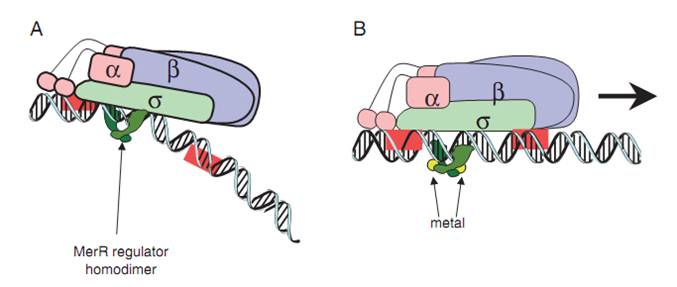Part:BBa_K346002
PmerT promoter (mercury-responsive)
Introduction
This part, PmerT, is a promoter from Tn21 mercury resistance (mer) operon. The mer operon of Tn21 consists of two tightly overlapped, divergently oriented promoters – Pr and Ptpad.(Park, Wireman et al. 1992). Pr is the promoter of the regulatory protein gene, merR, and Ptpcad is for the transcription of the structural gene – merPTAD. They are called merOP as a whole.
Fig.1. The MerR protein, in the form of homodimer, binds to the mer operon between the RNA polymerase binding sites of the promoter region. The attachment is independent on the presence of Hg(II).
The key sequence for MerR’s binding is a region of interrupted dyad symmetry (19bp) located between the -35 and -10 haxamers of Ptpcad (The top strand). And the structure of Pr (botton strand) is similar to Ptpcad in a divergent orientation. The -10 hexamers of Ptpcad and Pr actually overlap by four bases. When the apo-MerR dimer bind to the dyad symmetrical operator DNA between the -35 and – 10 elements of mercury inducible promoter, PmerT, which has a unusually long spacer of 19 bp for MerR to bind on, the binding of RNA polymerase is inhibited. When Hg(II) is available in the environment, the ion binds to merR between the two subunits(Fig.1). The Hg-bound MerR can result in an a structural distortion of PmerT, allowing the RNA polymerase contacts to be made, leading to the expression of down-stream genes. This mode of transcription activation indicates that as the apo-MerR and Hg-bound MerR have a competing relationship. The initiation of PmerT is controlled by the expression level of MerR, and the activity of which can be denoted by reporter genes. Thus the sensitivity of Hg(II) in cell can be manipulated.
For the characterization of merR, you may want to click the link here[1].
Methods
Fig.2. DNA sequence of the Tn21 mer operator promoter region. The MerR binding site on PmerT is marked by a box. The -35 and -10 regions for both PmerR and PmerTPAD are marked with boxes, and the dyad symmetrical DNA sequence that MerR recognizes and binds to is marked with arrows under the DNA sequence. A: The divergently oriented promoters are marked by blue box and purple box, respectively. B: In our project, the expression intensity of MerR should be maintained exogenously, so the divergent promoter Pr (of MerR transcript) was also removed by deletion of its -35 region. The resulted promoter sequence is marked with a dark purple box Modified from (Hobman, Wilkie et al. 2005)
In our design, merR was isolated from the operon and assembled with constitutive promoters of certain strength to maintain its expression intensity at certain level. For the same reason, the divergent promoter Pr was also removed by deletion of its -35 region(Fig.2).
For more information, please check 'experience' and our wiki!
Sequence and Features
- 10COMPATIBLE WITH RFC[10]
- 12COMPATIBLE WITH RFC[12]
- 21COMPATIBLE WITH RFC[21]
- 23COMPATIBLE WITH RFC[23]
- 25COMPATIBLE WITH RFC[25]
- 1000COMPATIBLE WITH RFC[1000]
//promoter
//regulation
| chassis | it works in DH5 alpha |
| n/a | PmerT promoter (mercury-responsive) |


